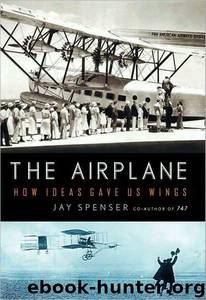The Airplane by Jay Spenser

Author:Jay Spenser
Language: eng
Format: mobi, epub
ISBN: 9780061980442
Publisher: HarperCollins
Published: 2008-01-02T00:00:00+00:00
9 FLIGHT DECK
COCKPITS FOR AERIAL SHIPS
Deep into the darkness peering; long I stood there wondering, fearing…
—“THE RAVEN” BY EDGAR ALLAN POE (1809–1849)
As human beings built their flying machines in the opening years of the last century, they gave them open cockpits reminiscent of the wells from which a small sailboat is controlled (indeed, this is where aviation drew the term from). Instead of sheets, a tiller, and a compass, however, these aerial vehicles surrounded their operators with flight controls and instruments.
Early on, people had different ideas of how human beings should physically occupy their airplanes. The Wrights flew lying down, oriented like birds in flight to reduce air resistance. This changed in 1908 with their welcome adoption of upright seating.
When Brazilian aviation pioneer Alberto Santos-Dumont performed Europe’s first officially witnessed hop by a powered aircraft in October 1907, he flew his Santos-Dumont 14-bis standing up. Grafted into the middle of the odd machine’s fuselage was what looked like a wicker balloon basket. It was obvious Santos-Dumont had come to heavier-than-air flight from balloons and dirigibles.
Common sense generally prevailed, however, and most first-generation aviators, successful or not, rightly assumed a person should sit down to fly. But even in the seminal year 1909, when successful flying really took off in the wake of Wilbur’s demonstrations at Le Mans the previous year, this was where agreement ended.
For example, Louis Blériot sat in his Blériot XI like an automobile driver, whereas Hubert Latham sat atop his Antoinette as if crewing a rowboat. And when Santos-Dumont finally came up with a working airplane, he huddled beneath the wing and engine of his Demoiselle. So low was he seated that his gloved hands served as wheel brakes.
Similar confusion attended the flight controls. The Wrights at different times used the motion of pulling back or pushing forward on a lever to lower the nose of their gliders (the latter, being intuitive, won out). As late as 1908, the Wright Model A—their first airplane produced in number—had two different control systems, one reflecting Orville’s preference for rudder actuation and the other Wilbur’s.
Some early airplanes sported control wheels while others had sticks. The Antoinette had fore-and-aft control wheels mounted perpendicular to the direction of flight at the sides of its cockpit. A pilot would control the ailerons by rolling the left-hand wheel forward or backward and the elevator by doing the same with the wheel at right. As for the rudder, a pivoting foot bar controlled that.
The Blériot XI had a wheel on top of a control stick, but this wheel didn’t turn. Instead it simply served as a round grip. The elevator was actuated by moving this wheeled stick forward or aft, while wing warping was controlled by side-to-side movements. The stick could be moved to any quadrant in a circle for combined inputs.
This excellent idea was actually developed independently by Robert Esnault-Pelterie and Louis Blériot. It is called the cloche (French for “bell”) control system. The name refers to the shape of the bottom end of the control stick below the universal joint allowing it to pivot.
Download
This site does not store any files on its server. We only index and link to content provided by other sites. Please contact the content providers to delete copyright contents if any and email us, we'll remove relevant links or contents immediately.
| Airport | Commercial |
| Helicopters | History |
| Pictorial | Piloting & Flight Instruction |
| Repair & Maintenance |
Small Unmanned Fixed-wing Aircraft Design by Andrew J. Keane Andras Sobester James P. Scanlan & András Sóbester & James P. Scanlan(32763)
Navigation and Map Reading by K Andrew(5131)
Endurance: Shackleton's Incredible Voyage by Alfred Lansing(4715)
And the Band Played On by Randy Shilts(2163)
The Box by Marc Levinson(1962)
Top 10 Prague (EYEWITNESS TOP 10 TRAVEL GUIDES) by DK(1953)
Wild Ride by Adam Lashinsky(1950)
The Race for Hitler's X-Planes: Britain's 1945 Mission to Capture Secret Luftwaffe Technology by John Christopher(1836)
The One Percenter Encyclopedia by Bill Hayes(1810)
Trans-Siberian Railway by Lonely Planet(1725)
Girls Auto Clinic Glove Box Guide by Patrice Banks(1705)
Bligh by Rob Mundle(1675)
Looking for a Ship by John McPhee(1650)
Good with Words by Patrick Barry(1638)
Batavia's Graveyard by Mike Dash(1629)
TWA 800 by Jack Cashill(1625)
Fighting Hitler's Jets: The Extraordinary Story of the American Airmen Who Beat the Luftwaffe and Defeated Nazi Germany by Robert F. Dorr(1610)
Troubleshooting and Repair of Diesel Engines by Paul Dempsey(1576)
Ticket to Ride by Tom Chesshyre(1564)
